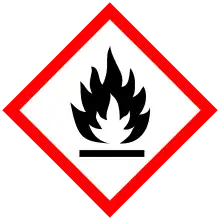| Names | |
|---|---|
| Preferred IUPAC name
Methanedithiol | |
| Other names
Dimercaptomethane | |
| Identifiers | |
3D model (JSmol) |
|
| ChemSpider | |
| ECHA InfoCard | 100.166.842 |
PubChem CID |
|
| UNII | |
CompTox Dashboard (EPA) |
|
| |
| |
| Properties | |
| CH4S2 | |
| Molar mass | 80.16 g·mol−1 |
| Appearance | Colorless liquid |
| Boiling point | 58 °C (136 °F; 331 K) |
Refractive index (nD) |
1.581 |
| Hazards | |
| GHS labelling: | |
 | |
| Warning | |
| H226 | |
| P210, P233, P240, P241, P242, P243, P280, P303+P361+P353, P370+P378, P403+P235, P501 | |
Except where otherwise noted, data are given for materials in their standard state (at 25 °C [77 °F], 100 kPa).
Infobox references | |
Methanedithiol is an organosulfur compound with the formula H2C(SH)2. It forms when formaldehyde is treated with hydrogen sulfide under pressure. The reaction competes with formation of trithiane. The compound forms a solid dibenzoate upon treatment with benzoic anhydride.[1]
References
- ↑ Cairns, T. L.; Evans, G. L.; Larchar, A. W.; McKusick, B. C. (1952). "gem-Dithiols". Journal of the American Chemical Society. 74 (16): 3982–9. doi:10.1021/ja01136a004.
This article is issued from Wikipedia. The text is licensed under Creative Commons - Attribution - Sharealike. Additional terms may apply for the media files.